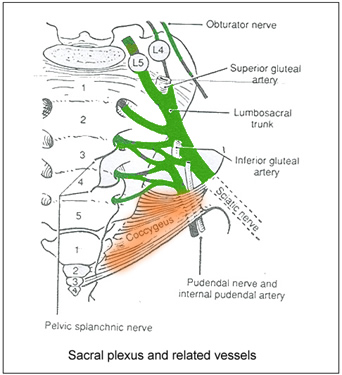Nerve supply |
|
|
 |
- Derived from sacral and coccygeal spinal neres
- Pelvic part of autonomic nervous system
- Each of the five sacral nerves divides into a dorsal and ventral ramus within the sacral canal
- The dorsal rami of the first four sacral nerves pass backward through the dorsal sacral foramina.
- Those of the fifth sacral and coccygeal emerge from the sacral canal through the sacral hiatus
- The ventral rami of the first four sacral nerves emerge from the sacral canal through the pelvic sacral foramina.
- The third and fourth sacral and occassionaly the second or fifth also, give off the pelvic splanchnic nerves which help form the autonomic plexus within the pelvis.
|
|
Sacral plexus |
|
|
- Formed by the ventral rami of the fourth and fifth lumbar and first four sacral nervers.
- Ventral ramus of the fourth lumbar divides into upper ad lower parts.
- The lower division joins the ventral ramus of the fifth lumbar nerve to form the lumbosacral trunk
- The lumbosacral trunk descends and joins the ventral ramus of the fourth sacral also has upper and lower divisions.
- Its upper part joins the third sacral, its lower part the fifth sacral.
- With the exception of the fourth sacral, each ventral ramus first divides inot ventral and dorsal branches before entering into the formation of the sacral plexus.
|
|
| Relations |
|
|
- Lies infront of piriformis
- Separated from the internal iliac vessels and ureters anterioly by the parietal pelvic fascia
- Superior gluteal vessels pass between the lumbosacral trunk and the ventral branches of the first and second or second and third sacral nerves
- The internal pudendal vessels run between the sciatic and pudendal nerves.
|
|
Distribution |
|
|
- The sacral plexus had twelve branches.
- Seven of these supply the buttock and lower limb, the rest supply structures belonging to the pelvis.
These are.
Nerve |
Root value |
Course and Distribution |
|
| Buttock and Lower Limb |
| |
|
|
| Superior gluteal nerve |
L4,5,S1
|
- Accompanies superior gluteal vessels into the buttocks where it is distributed
|
| Inferior gluteal nerve |
L5, S1, 2 |
|
Nerve to quadratus femoris
|
L4,5,S1 |
- Supplies inferior gamellus
- quadratus femoris
- Hip jointy
|
| Nerve to obturator internus |
L5, S1, 2
|
- Superior gamellus
- Obturator internus
|
Posterior femoral cutaneous
|
S1,2,3 |
|
Perforating cutaneous |
|
S2, S3 |
- Skin
- Subcutaneous tissue of the lower part of buttock
|
| Sciatic nerve |
L4, 5, S1, 2, 3 |
- The largest in the body
- Peroneal and tibial bound together
- Leaves pelvis through greater sciatic foramen
|
|
| |
|
|
| Pelvis |
|
|
|
| Nerve to piriformis |
S1, S2 |
|
| Nerve to levator ani and coccygeus |
S3, 4 |
|
| Nerve to sphincter ani externus |
S4 |
- sphincter ani externus as well as the surrounding and subcutaneous tissue
|
Pelvic splanchnic nerves
|
S2, 3,4,5 |
- Contain parasympathetic preganglionic and sensory fibres
- Supply sigmoid colion
|
| Pudendal nerve |
s2, 3,4 |
- Furnishes most of the perineum.
- It has motor and sensory fibres post ganglionic sympathetic fibres
|
|
| |
|
COCYGEAL PLEXUS |
|
|
- Formed by ventral rami of the fifth sacral and the coccygeal nerve which join the lower division of the ventral ramus of the fourth sacral
- It supplies the sacrococcygeal joint, the coccyx, and the skin the coccyx.
|
|
PELVIC PART OF AUTONOMIC NERVOUS SYSTEM |
|
The symphathetic part of the autonomic nervous system reaches the pelvis by two different routes.
- The downward continuation of the sympathetic trunk, and
- The downward continuation of the aortic plexus
|
|
